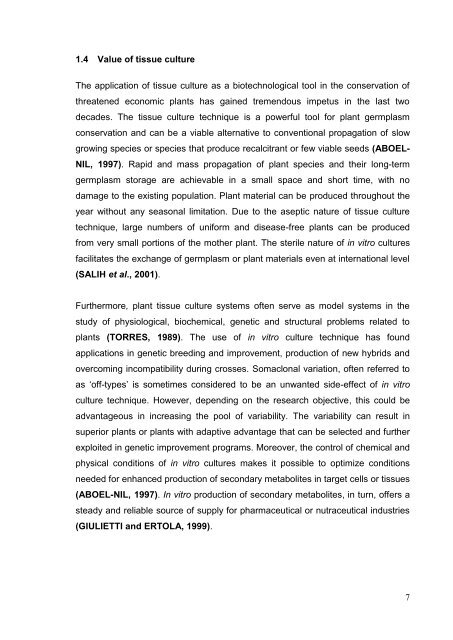Micropropagation and medicinal properties of Barleria greenii
Micropropagation and medicinal properties of Barleria greenii
Micropropagation and medicinal properties of Barleria greenii
Create successful ePaper yourself
Turn your PDF publications into a flip-book with our unique Google optimized e-Paper software.
1.4 Value <strong>of</strong> tissue culture<br />
The application <strong>of</strong> tissue culture as a biotechnological tool in the conservation <strong>of</strong><br />
threatened economic plants has gained tremendous impetus in the last two<br />
decades. The tissue culture technique is a powerful tool for plant germplasm<br />
conservation <strong>and</strong> can be a viable alternative to conventional propagation <strong>of</strong> slow<br />
growing species or species that produce recalcitrant or few viable seeds (ABOEL-<br />
NIL, 1997). Rapid <strong>and</strong> mass propagation <strong>of</strong> plant species <strong>and</strong> their long-term<br />
germplasm storage are achievable in a small space <strong>and</strong> short time, with no<br />
damage to the existing population. Plant material can be produced throughout the<br />
year without any seasonal limitation. Due to the aseptic nature <strong>of</strong> tissue culture<br />
technique, large numbers <strong>of</strong> uniform <strong>and</strong> disease-free plants can be produced<br />
from very small portions <strong>of</strong> the mother plant. The sterile nature <strong>of</strong> in vitro cultures<br />
facilitates the exchange <strong>of</strong> germplasm or plant materials even at international level<br />
(SALIH et al., 2001).<br />
Furthermore, plant tissue culture systems <strong>of</strong>ten serve as model systems in the<br />
study <strong>of</strong> physiological, biochemical, genetic <strong>and</strong> structural problems related to<br />
plants (TORRES, 1989). The use <strong>of</strong> in vitro culture technique has found<br />
applications in genetic breeding <strong>and</strong> improvement, production <strong>of</strong> new hybrids <strong>and</strong><br />
overcoming incompatibility during crosses. Somaclonal variation, <strong>of</strong>ten referred to<br />
as „<strong>of</strong>f-types‟ is sometimes considered to be an unwanted side-effect <strong>of</strong> in vitro<br />
culture technique. However, depending on the research objective, this could be<br />
advantageous in increasing the pool <strong>of</strong> variability. The variability can result in<br />
superior plants or plants with adaptive advantage that can be selected <strong>and</strong> further<br />
exploited in genetic improvement programs. Moreover, the control <strong>of</strong> chemical <strong>and</strong><br />
physical conditions <strong>of</strong> in vitro cultures makes it possible to optimize conditions<br />
needed for enhanced production <strong>of</strong> secondary metabolites in target cells or tissues<br />
(ABOEL-NIL, 1997). In vitro production <strong>of</strong> secondary metabolites, in turn, <strong>of</strong>fers a<br />
steady <strong>and</strong> reliable source <strong>of</strong> supply for pharmaceutical or nutraceutical industries<br />
(GIULIETTI <strong>and</strong> ERTOLA, 1999).<br />
7

















